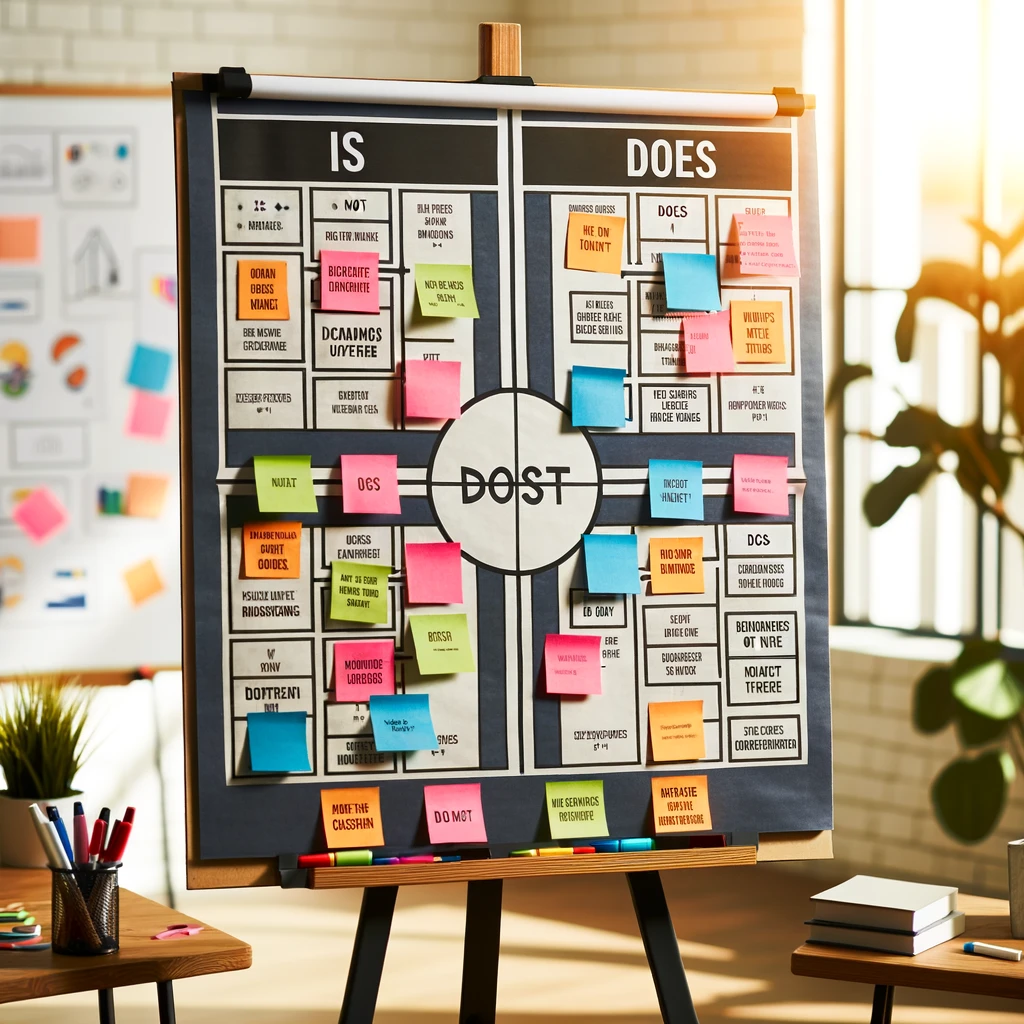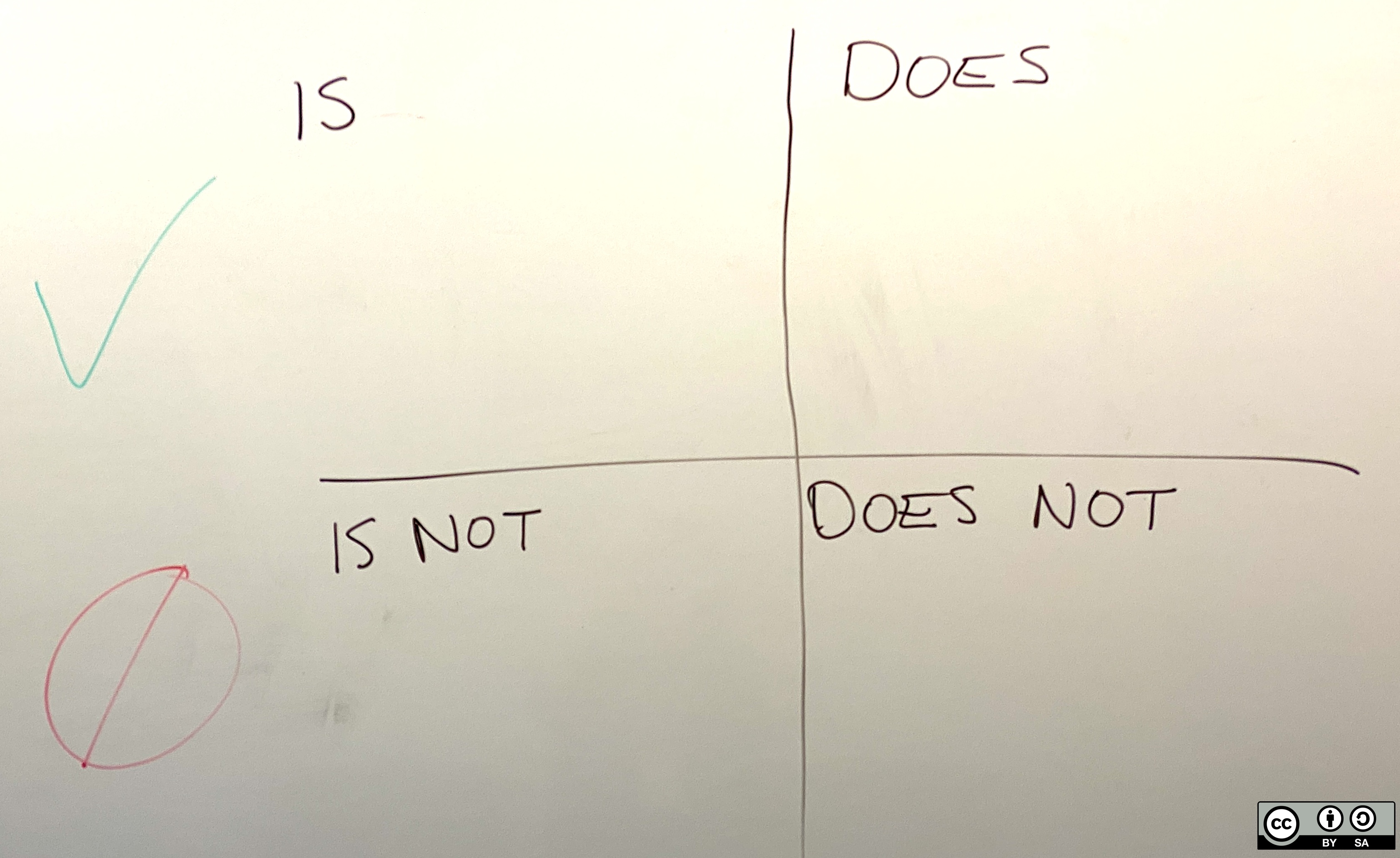Is – Is not – Does – Does not
Provide a structured approach for clearly understanding and defining a problem, object, concept, or situation.
Moises Romero
What Is Is – Is not – Does – Does not?
This method helps in breaking down complex or ambiguous scenarios into more manageable and distinct components. Here's a breakdown of the objectives for each part of the analysis:
- Is: The goal here is to identify and describe what the subject of the analysis actually is. This part focuses on the characteristics, attributes, qualities, or properties that are definitively present. By specifying what the subject is, you provide a clear and concise description that forms the foundation for further analysis.
- Is Not: This section aims to clarify what the subject is not. It's about distinguishing the subject from other similar or related entities. This helps in avoiding confusion and setting clear boundaries for what is being considered. By understanding what the subject is not, you prevent scope creep and keep the focus on the relevant aspects.
- Does: The objective here is to determine and describe what the subject does. This involves outlining the actions, functions, behaviors, or roles of the subject. It's crucial for understanding the capabilities or effects of the subject, which is particularly important in problem-solving and product development.
- Does Not: Finally, this part outlines what the subject does not do. It's about understanding the limitations or non-functions of the subject. This is particularly useful for setting realistic expectations, understanding constraints, and identifying potential areas for improvement or innovation.
Is – Is Not – Does – Does Not practice is part of Paulo Caroli's Lean Inception methodology, it's a versatile and effective tool that can be applied in many other contexts, independently of Lean Inception.
Why Do Is – Is not – Does – Does not?
Clear Definition and Focus: One of the most significant challenges in addressing any problem or developing any product is accurately defining what it is and what it isn't. Without clear boundaries, there's a risk of scope creep, where the project or problem becomes larger and more unwieldy than initially intended. This practice helps in setting clear boundaries, ensuring that the focus remains on the relevant aspects. It reduces ambiguity and helps all stakeholders have a shared understanding of what is being discussed or addressed.
Improved Problem-Solving: Effective problem-solving requires a deep and precise understanding of the problem. By breaking down what the problem is and isn’t, and what it does and doesn’t do, you can identify the root cause more effectively. This methodical breakdown can lead to more effective solutions, as it prevents overlooking critical aspects of the problem and ensures that the solutions are targeted and appropriate.
Enhanced Communication and Collaboration: In any team or collaborative environment, communication is key. The "Is – Is Not – Does – Does Not" practice provides a common language and framework for discussion. It helps in aligning team members’ understanding and perspectives, reducing misunderstandings and misinterpretations. This clarity is crucial, especially in complex projects or when dealing with interdisciplinary teams, where each member might have different areas of expertise and viewpoints.
How to do Is – Is not – Does – Does not?
Preparing for the Session
- Define the Objective: Clearly understand and communicate the purpose of the session to the team. What are you trying to analyze or solve?
- Select Participants: Choose a diverse group of team members who have different perspectives or expertise related to the subject.
- Schedule and Set Up: Organize a meeting at a time convenient for all. Ensure the meeting space (physical or virtual) is conducive to open discussion.
Conducting the Session
-
Introduction:
- Explain the Technique: Start by explaining the "Is – Is Not – Does – Does Not" method and its importance.
- Set Ground Rules: Encourage openness, respect for different opinions, and a non-judgmental environment.
-
Is:
- Prompt Discussion: Ask, "What is [the subject]?" Encourage team members to describe what they believe the subject definitely is.
- Facilitate and Record: Facilitate the discussion, ensuring all voices are heard. Record all valid points on a visible medium like a whiteboard or shared document.
-
Is Not:
- Guide the Conversation: Next, ask, "What is [the subject] not?" This helps in setting boundaries and clarifying misconceptions.
- Encourage Clarity: Ensure that the contributions here are focused on what the subject explicitly is not, avoiding overlaps with the "Is" category.
-
Does:
- Focus on Actions/Functions: Ask, "What does [the subject] do?" This should bring out the functions, actions, or roles of the subject.
- Ensure Comprehensive Coverage: Make sure all aspects of what the subject does are covered, prompting the team as needed.
-
Does Not:
- Discuss Limitations: Finally, ask, "What does [the subject] not do?" This part is crucial for understanding limitations or misconceptions about the subject's capabilities.
- Promote Honesty: Encourage the team to be realistic about the limitations, which is often crucial for problem-solving.
Post-Session Activities
- Synthesize Information: After the session, compile all the points discussed into a coherent document.
- Review and Refine: Share this document with the team for review. Ask for any additional thoughts or refinements.
- Distribute Final Document: Once finalized, distribute this document to the team and relevant stakeholders.
- Action Plan: Depending on the purpose of the session, develop an action plan based on the insights gained.
Tips for Effective Facilitation
- Encourage Participation: Make sure everyone gets a chance to speak. Be attentive to quieter team members who might have valuable insights.
- Manage Dominant Voices: Ensure that no one person dominates the conversation. Facilitate a balanced discussion.
- Keep the Discussion on Track: Steer the conversation back if it strays too far from the topic.
- Ask Open-Ended Questions: This encourages deeper thinking and more detailed responses.
- Summarize and Clarify: Regularly summarize points for clarity and to ensure accurate recording of ideas.
- Be Neutral: As a facilitator, maintain neutrality and focus on guiding the discussion rather than contributing content.
Look at Is – Is not – Does – Does not
Links we love
Check out these great links which can help you dive a little deeper into running the Is – Is not – Does – Does not practice with your team, customers or stakeholders.


